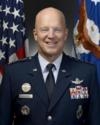Embraces Space Force As A New, Separate Military Branch
Air Force Gen. John Raymond, recently confirmed to lead the U.S. Space Command, emphasized on Sept. 27, the singular need for a Space Force and the steps required to maintain U.S. preeminence in a “domain” that is becoming increasingly crowded, dangerous and essential.

“We’re planning for a Space Force. We need a Space Force. Our nation needs a Space Force,” Raymond said in remarks at a Mitchell Institute breakfast on Capitol Hill attended by influential members of Congress and staff as well as defense analysts, industry officials and media.
“We’re very hopeful that Congress will pass in the coming months a (National Defense Authorization) that will allow that to happen,” he said.
But while Congress continues to debate both the form, function and necessity of the Space Force, Raymond detailed in his remarks an array of actions and achievements that have already been realized to strengthen the United States’ presence and capabilities in space.
The reason – and the imperative – is clear, he said. “Space fuels our American way of war. Space fuels the American way of life,” he said. “Your smart phone is pretty stupid without space. We need to articulate what space capabilities do for our nation and we’re doing that every chance we can.”
Almost all of the changes and upgrades are in response to the National Defense Strategy, which identifies space – and the defense of space – as a key national security imperative.
With that mandate, the progress achieved since is “probably the most consequential 16 months in the history of National Security Space,” he said.
One of the most important took place Aug. 29, when Secretary of Defense Mark Esper formally established the U.S. Space Command as the country’s 11th unified combatant command. “This is a different command built for a different time and a different strategic environment, he said.
Other changes are harder to see and might seem mundane. But Raymond said they are not and taken together they ensure that the U.S. will maintain its historic advantage in space.
Among them is a new focus on space specific training that will produce airmen specializing in space operations and tactics. The best example of the effort is the Schriever Scholars program that is a year-long class, he said.
It includes new and refined efforts to work closer with industry so that innovations can be found and used faster. A chief data officer has been installed to refine and improve the enormous use of information and communication that is tightly connected with successful operations in space.
The effort also includes strong ties to allies and partners. The clearest example of that, he said, occurred in April when air chiefs from 12 nations gathered in Colorado to discuss space. The goal was to forge a better understanding of how best to adapt together to the more contested and dangerous environment and to find ways to maximize and streamline the partnerships into a cohesive, effective whole. A second air chiefs meeting is scheduled for 2020.
The first Coalition Space Flag exercise was held, bringing together Canada, the United Kingdom and Australia. Another will be held in 2020.
Raymond also said efforts are underway to reassess the way information is classified so that partnerships with industry can be more fully realized. It’s also important, he said, because public information and displays of some capabilities are critical to effective deterrence.
Deterrence is one of the four major missions of the space effort, he said. The others are: defend, deliver (as in combat power and operations) and develop a new class of warfighters specifically educated in space tactics and operations.
(Source: USAF news release. Image from file)
 ANN's Daily Aero-Term (04.24.24): Runway Lead-in Light System
ANN's Daily Aero-Term (04.24.24): Runway Lead-in Light System ANN's Daily Aero-Linx (04.24.24)
ANN's Daily Aero-Linx (04.24.24) Aero-FAQ: Dave Juwel's Aviation Marketing Stories -- ITBOA BNITBOB
Aero-FAQ: Dave Juwel's Aviation Marketing Stories -- ITBOA BNITBOB Classic Aero-TV: Best Seat in The House -- 'Inside' The AeroShell Aerobatic Team
Classic Aero-TV: Best Seat in The House -- 'Inside' The AeroShell Aerobatic Team Airborne Affordable Flyers 04.18.24: CarbonCub UL, Fisher, Affordable Flyer Expo
Airborne Affordable Flyers 04.18.24: CarbonCub UL, Fisher, Affordable Flyer Expo



